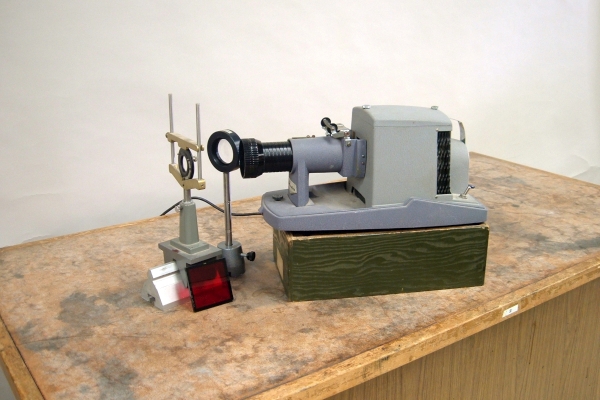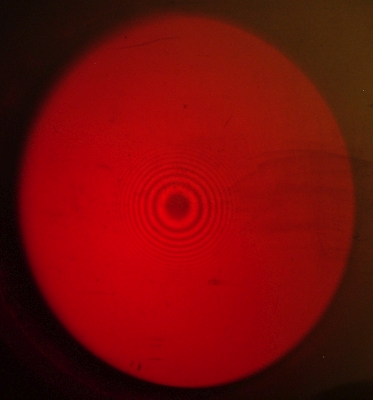 |
 |
A glass plate, one surface of which is slightly convex, sits with its convex surface touching the surface of a second, flat, glass plate. The two plates are held between metal retainers, which can be gently tightened and set parallel by means of three thumbscrews. (This ensures that the point of contact is in the center; there should be no need to adjust these during class.) A projector illuminates the apparatus, and a lens focuses the reflected light onto a screen, producing an image like the one shown at right. You can place a red filter (the red square plate leaning against the optical carriage in the photograph) either between the apparatus and the lens, or in front of the lens. By filtering out the light of higher frequency, this improves contrast and makes the fringes somewhat clearer.
Demonstration 84.24 -- Soap film interference, shows what happens when light enounters a thin medium whose index of refraction is higher than that of the surrounding medium. In this demonstration, light passes through two glass plates, between which is a thin layer of air, whose thickness varies with the distance from the center of the plates, according to the curvature of the rear face of the first plate. Because the index of refraction of air is lower than that of glass, light reflected from the back surface of the first plate does not undergo a change in phase, but the light reflected from the front surface of the second plate (the back surface of the layer of air) returns 180° out of phase with the incident light, and thus 180° out of phase with the light reflected from the front of the air layer. These two reflected beams undergo interference. (There are reflections from both the front surface of the front plate, and the back surface of the rear plate, but their effects are small compared to those from the two surfaces of the air layer.) If we call the thickness of the air layer d, then the difference in path length for the light reflected from the back of the air layer with respect to that reflected from the front of the air layer is 2d. Whether the interference is constructive or destructive depends on how many wavelengths of the light fit within this path difference. The condition for maximum intensity is similar to that for the soap film, and is:
2d = (m + 1/2)λ m = 0, 1, 2, . . .,
where λ is the wavelength of the light; we are taking the index of refraction of air to be equal to 1. Since the air layer is radially symmetrical, the interference pattern is a dark spot in the center, with a series of concentric rings around it. These are known as Newton’s rings, because he studied and analyzed them, though they were first observed and described by Robert Hooke. At the central dark spot, the air layer is so thin, that the light reflected from the back of the air layer remains 180° out of phase with that reflected from the front of the layer. (If the screws holding the apparatus together are tight enough, it is possible that right at the center of the dark spot, the contact between the two plates is good enough to eliminate the boundary between them, in which case the light there passes through unreflected.)
If we take the radius of curvature of the plano-convex plate to be R, and the radius of a circle about the center of the plate to be r, R is the hypotenuse of a right triangle whose sides are r and √(R2 - r2), and
d = R - √(R2 - r2).
Multiplying inside the radical by R2/R2 gives d = R - R[1 - (r/R)2]1/2. If r ≪ R (so r/R ≪ 1), we can expand the term in brackets. If we do this and keep two terms, we get
d = R - R[1 - (1/2)(r/R)2 + ···] ≅ r2/(2R).
So 2d = r2/R, and the condition for maximum intensity becomes
r2/R = (m + 1/2)λ m = 0, 1, 2, . . ., or
r = √[(m + 1/2)λR] m = 0, 1, 2, . . .,
where the values of r are the radii of the bright fringes. (The dark fringes occur for r = √(mλR), where m = 0, 1, 2, . . .) For white light, we observe sets of overlapping fringes from light of various wavelengths. In the photograph above, we see that the inner edge of each bright fringe appears blue, and the outer edge appears red. (And the dark fringes are between the red edge of one bright fringe and the blue edge of the next.) As noted above, placing a red filter either between the apparatus and the lens, or between the lens and the screen, filters out the light of higher frequencies, which slightly narrows the bright fringes and somewhat improves the contrast between the bright and dark fringes, as shown in the image below.
References:
1) Sears, Francis Weston and Zemansky, Mark W. College Physics, Third Edition (Reading, Massachusetts: Addison-Wesley Publishing Company, Inc., 1960), pp. 914-15.
2) Halliday, David and Resnick, Robert. Physics, Part Two, Third Edition (New York: John Wiley and Sons, 1977), pp. 1009-10.
3) Giancoli, Douglas C. Physics: Principles with Applications, Fifth Edition (Upper Saddle River, New Jersey: Prentice-Hall, 1998), p.740-1.
4) Jenkins, Francis A. and White, Harvey E. Fundamentals of Optics, Second Edition (New York: McGraw-Hill Book Company, Inc., 1950), 260-2.
5) https://sciencedemonstrations.fas.harvard.edu/presentations/newtons-rings.
